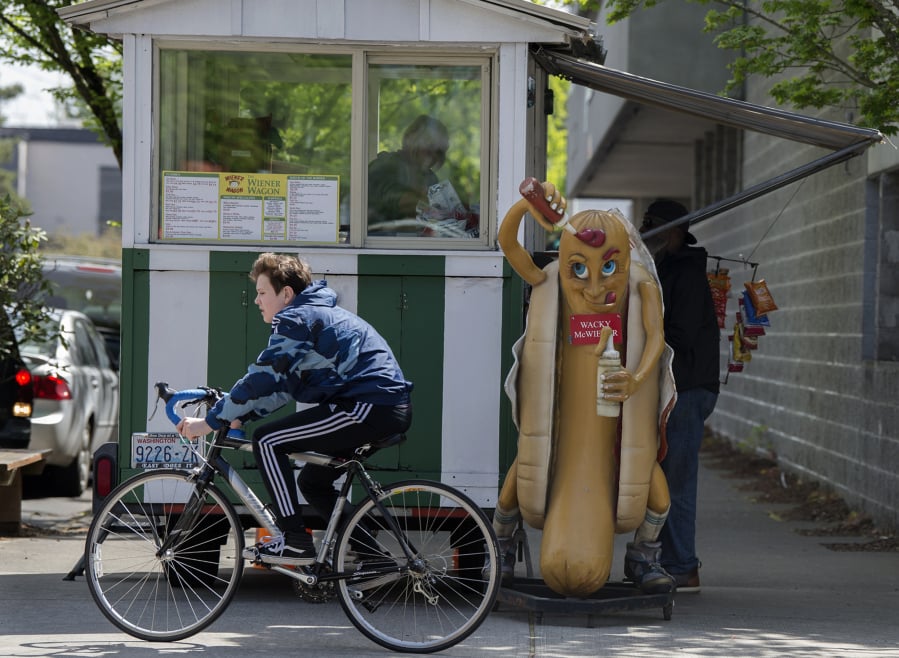Slowly but surely, Vancouver is evolving into a food-cart destination that could one day rival the thriving culture of Portland – but with an emphasis on the “slowly” part.
The past decade has seen many new carts hit the streets, but the measured pace of progress has been a source of occasional frustration for some of Vancouver’s food-cart operators, and a handful of recent closures has led to concerns that the momentum may have stalled.
“Where have all the food carts gone?” asks Kurt Müller, who operates Black Dog Hot Dogs at the corner of Franklin and 13th streets, as well as a couple of other spots downtown. “I don’t see any new ones really coming in.”
Most of them are still around, and a few vendors have recently set up shop. But there have been some notable closures, and the loss of even a few carts is acutely felt — there are still around 20 vendors in Clark County overall, according to a Visit Vancouver USA list.
“I think (food-cart growth) has kind of plateaued,” says Steve Valenta, owner of The Mighty Bowl restaurant. “I’m surprised they’re not taking off more.”
When asked what it will take for Vancouver to reach its true food-cart potential, the city’s food-cart operators offer different explanations — but there are some common points about the potential roadblocks faced by new carts, including a shortage of good operating locations and a streamlined-but-still-costly permitting system.
Food-cart renaissance
Many members of Vancouver’s food-cart community date the origins of the current wave of food carts to the emergence of The Mighty Bowl in 2012, which began life as a food truck before expanding into a brick-and-mortar space at 108 W. Eighth St.
It wasn’t an easy process to navigate. Valenta says he began working with the city as early as 2010 to try to figure out how to get the truck rolling.
“The city code was just antiquated,” he says — some of the codes pertaining to food carts used outdated terms such as “peddling” and “hawking.”
The Mighty Bowl’s success helped open the door for future vendors, he says — not only from a process standpoint, but as a proof of concept for would-be cart operators.
“It just gave people the confidence to take on that risk,” he says.
The Mighty Bowl isn’t the oldest cart in Vancouver, however. That honor goes to the Wiener Wagon on the southeast corner of West Main and 12th streets, which has been in operation for 42 years. Owner Robin Povec says she bought the cart about seven years ago, and says she’s seen Vancouver’s food-cart community thrive in the time since then.
“I’d like to see more of them,” she says. “It brings people down here.”
There have certainly been food-cart success stories in the past decade. The E-San Thai and Taco City trucks have operated in the parking lot next to Trap Door Brewing since at least 2016, and Vancouver resident Alex Mickle has spent several years transforming an old C-Tran bus depot on Seventh Street between Main Street and Broadway into a food-cart pod called Columbia Food Park, with cart vendors Mack Shack and Anchor End Pretzel Shoppe.
And the growth isn’t limited to downtown Vancouver. Hazel Dell is home to two food-cart pods, one in the parking lot of the future car museum at 1015 N.E. 78th St.,and the other outside of Brothers Cascadia Brewing at 9811 N.E. 15th Ave. off of Highway 99 — officially known as Hazel Dell Commons.
One of the most recent trucks to hit the streets was Linda Selivanow’s Coffee Villa, a mobile version of her former Orchards coffee shop, now based out of the Northeast 78th Street pod.
“I downsized,” she says.
But not everyone has made it, Valenta and Müller point out. Several vendors have emerged in the downtown and Hazel Dell areas in the past decade only to disappear, including Pimento Cheese Kitchen, Esoteric BBQ and Sunny’s Teriyaki Fusion BBQ. Another Columbia Food Park cart, Nomad’s Gourmet Hot Dogs, shut down last year and wrote on Facebook that it would be selling the business, but hasn’t posted anything since then.
The reasons for disappearances vary. In the case of Sunny’s, co-owner Steve Anderson still owns the cart’s home parking lot at the southwest corner of Mill Plain Boulevard and Washington Street, but said he and his wife sold the cart because the business was eating up too much of their time.
A Cajun-style food truck Fixins disappeared from Uptown Village last summer after its parking lot home at 2425 Main St. was sold. But according to a post on the business’s Facebook page, it relocated to the parking lot of Cliff’s Tavern at 8614 N.E. St. Johns Road — though a more recent post said it had closed down for the winter.
M?ller says enough carts have disappeared that he’s begun to worry about the status of the industry in Vancouver — particularly, he says, in light of rising permitting costs that can add up to several hundred dollars for a new cart, and a regulatory framework that remains cumbersome and daunting for new arrivals.
Costs and challenges
The list of required permits varies depending on the type of food cart being set up, according to a matrix on the city of Vancouver’s website. All pushcarts, trailers and trucks require a $200 city business license, a $25 city food vendor’s license and a Clark County health permit, which ranges from $367 to $1,400 depending on the type of mobile food operation, according to Briggette Bashaw, food program manager at Clark County Public Health.
Trucks and trailers also need approval from the state Department of Labor & Industries, which is another $128. Carts and trucks parking on city streets or sidewalks need a $28 city street use permit, and are subject to regular parking fees. Trucks also have an option to apply for a city pilot program that allows them to park in a metered stall without time limits or meter fees at a cost of $75 per month.
Those permit costs add up, Müller says, and the prices are rising. The annual business license cost rose from $125 to $200 this year, and the surcharge for each full-time equivalent employee rose from $50 to $90.
“This is the first year I’ve raised my prices since I came here,” he says.
Povec says the rising costs have hit her, as well, more than doubling in the seven years since she took over the Wiener Wagon.
Regulatory costs didn’t cause Sunny’s Teriyaki to shut down, Anderson says, but he says they’re likely to be an obstacle for new carts.
“The first thing I had to do on my private property was spend $3,000 on a site survey,” he says.
The city requires a site plan for permanent food trucks on private property. Getting the Sunny’s cart up and running required several modifications including an improved sidewalk next to the parking lot — for a total startup cost of around $8,000, Anderson says. That’s probably out of reach for a lot of potential food-cart startups.
Hummus Hummus owner Elias Shashati, who serves up Middle Eastern cuisine at the Hazel Dell Commons pod, says he too has been feeling the pinch from permitting costs. Clark County Public Health permits for him have risen in cost by 30 percent this year, he says. And the county’s regulations can also prove difficult to satisfy.
“They want five sinks,” he says, laughing. “I mean, how big is the truck?”
According to Bashaw, county food-permit fees rose by an average of 32 percent this year, and mobile permits increased by about 24-25 percent. The increases were prompted by a Clark County Council directive to implement a 100 percent cost recovery fee schedule, she said, which came after seven years of minimal permit-fee increases.
The required number of sinks varies based on the type of food truck, she added, but in some cases five sinks are required — a standard three-compartment sink for dishwashing, plus a separate sink for hand washing and another for food preparation such as washing produce.
Shashati says the costs need to come down and the regulations need to be streamlined in order to allow Vancouver’s food-cart scene to continue to grow — though he still ranks that issue as the third most important for a new food cart, behind the location and customer access.
That’s what prompted him to set up shop at Brothers Cascadia, he says. He and the neighboring Pizzaria La Sorrentina cart began their operations at the Northeast 78th Street pod, but Shashati says he found that the parking lot access from the thoroughfare was too limiting for potential customers. So when Brothers Cascadia invited him to move, he jumped at the chance.
Hummus Hummus also makes appearances at the Vancouver’s downtown farmers market. Shashati says he ventured elsewhere into downtown Vancouver last year, but struggled both with the permit process and finding a good location.
“Vancouver, it seems like they have too much restriction on food carts,” he says. “It’s not like Portland.”
Sidewalk vendors have hoops to jump through, as well, as Chunney Pop owners Chelsea and Cory Chunn found out last year when they began operating their pushcart at The Waterfront Vancouver, only to discover that the area’s 2009 development agreement restricted outside businesses.
Sidewalk vendors need special event permitting to operate in the waterfront district or on sidewalks next to Esther Short Park, according to Vancouver economic development division manager Teresa Brum. Food trucks are subject to the same waterfront restrictions unless they park on Esther or Grant streets on the first block past the railroad berm.
The Port of Vancouver’s Terminal 1 development next to the waterfront district should could become a home for riverfront food carts, though port spokeswoman Magan Reed says it’s still too early to know for sure.
“It’s definitely a topic of conversation that has come up in our working group here,” she says.
One final explanation Valenta offers for the slow growth: Food carts are simply a tough business and not everybody is going to make it. Each cart has to be able to develop its own business model, he says, with a product that can generate sustained sales and a customer base willing to stop by.
Valenta also points to Vancouver’s size as an explanation for some of the carts’ struggles. For all the growth the city has seen in the past decade, he says, it still doesn’t have the population density needed to support the kind of food-cart pods found in Portland, where 30 carts can coexist on a single city block.
“It feels like we’re all on our own islands, doing our own thing, kind of lying in wait for our emerging city to gain the density that we need to sustain mobile restaurants,” he says.




